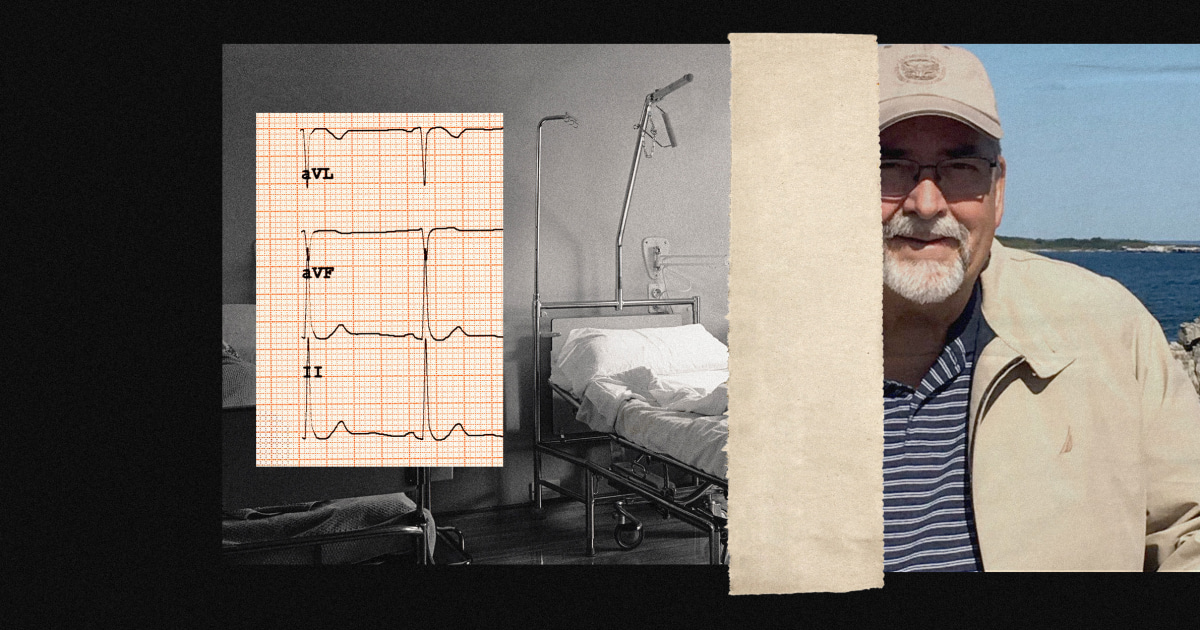The hospital staffers who watch heart rhythms are usually “telemetry” technicians, not nurses. At HCA Healthcare facilities, they may monitor as many as 80 patients at a time.
After three harrowing weeks in the hospital, Terry Downs, 68, was on a path to recovery. A former Boeing engineer who helped design the stealth bomber, Downs was admitted to HCA Healthcare’s Wesley Medical Center in Wichita, Kansas, in July 2022 with what was found to be a brain bleed. By month’s end, he was scheduled for discharge from the 760-bed facility and headed for rehabilitation.
He never made it. In the wee hours of Aug. 1, a nurse walking by his room heard him choking and found his heart barely beating. A half hour earlier, his pulse had been strong, Downs’ 2,200-page hospital record shows, but when his heart rhythm changed, no one assigned to monitor it had alerted nurses.
In Wesley Medical Center, and in most hospitals today, the people monitoring patients’ heart rhythms, blood pressure or respiratory functions are not nurses who interact with them. They are “telemetry” technicians who are supposed to alert those nurses to meaningful changes in the vital signs transmitted by electronic devices hooked up to the patients.
I don’t know if that’s bad or not. I don’t expect a person to be looking at my vitals unless something is wrong, in which case i assumed a computer would be better than a human (just like how humans suck at airport security)
Seems from the article that it’s about the telemetry techs being overworked:
The technicians “are juggling too much,” she said. “I’ve been in situations where a team has activated a code blue before we even got a phone call from the telemetry tech. They can’t keep up.”
…
A January 2023 report by the Service Employees International Union, some of whose members work at HCA facilities, said HCA staffing was inadequate and called out telemetry as a concern. “Monitor techs are routinely required to be responsible for dangerously high numbers of patients,” the report noted.
…
During a recent weekend, telemetry monitoring at the facility went down for 26 hours, according to Melissa Gong, a registered nurse on a telemetry floor there. The facility has about 95 beds monitored for telemetry, Gong said, watched by two technicians who also do other work, such as answering phones when the unit is short-staffed.
This seems like bad design. Not that it’s monitored remotely but that it needs a person as the only monitor. We should be able to get the frequency of the heart beat and the amplitude, not as a picture but as numbers. Once in number form it should be easy to program a system where say (making up numbers as I am not a doctor) a change of > 5% in frequency or a change of <10 % in amplitude triggers an automatic signal to the nurse.
A person should not decide “is that significant enough to trigger a call”
Talking about bad designs, check this out:
Julie Griffin, an intensive care unit nurse and former aviation electronics technician in the military, started working at HCA Florida Westside Hospital in Plantation in 2016. Because ICU patients require significant attention, each nurse in these units is supposed to watch over two patients at most. Griffin told NBC News she was asked to monitor three patients at Westside, even though the telemetry screen could only show heart rhythms for two patients at a time. That left one patient unmonitored.
The system should monitor it, and pop up a alarm when something is unusual, with say the last 5 minutes of data, and then the person monitoring should relay all pertinent info to a nurse.
Although at that point why not send the information directly to the nurse?
The problem is you’re asking hospitals to spend a few million in licensing fees for such a system. That shit has to be FDA approved, which is extremely expensive.
That’s harder to get approved because the finance people only think a quarter at a time.
Remember, if there’s a bug in your code, people will literally die.
I work in medical devices and understand the cost/responsibilities of of Healthcare systems.
That said we don’t need any new monitors. We can detect a person’s heartbeat. To display it on the screen we must have the frequency and amplitude. As I said I’m not a doctor so I can’t say what should be a “alarm” situation but we must know this since we teach people to do it.
The biggest issue is converting human talk to machine code which is not a large barrier. The financial gains are huge, these “telememetry nurses” can’t be cheap. A company makes this for say 20 million(no new technology, regulatory submission and some programmers). Sell it to hospitals for 20k a year…
How many hospitals would turn down reducing headcount by 30-70 people at 80k each(not net but including insurance and pto and holidays etc etc, just estimating) for a single bill of 20k a year? Hell go 10x and charge 200k, still an easy sell.
This is the perfect application of the new ML we have available.
The idea seems obvious but if have the backing to get through regulatory submissions hit me up.
I’m a nurse on a cardiac critical care unit. Let me provide some insight here.
There’s a reason I joke to my patients that reading a telemetry monitor is a little bit like reading tea leaves. It’s WAY less precise than members of the general public assume.
First though, there seems to be a little confusion in the comments on exactly what kind of monitoring we’re talking about. This is specifically continuous monitoring of heart rhythms via cardiac electrical activity. Telemetry monitoring does provide a heart rate, but these technicians are not also monitoring other vitals like blood pressure, temperature, and oxygen saturation. Outside of a critical care unit, we don’t leave patients continuously hooked up to those things because it’s unnecessary and it’s annoying and inconvenient for the patient.
So this is specifically about technicians who are not physically near a patient noticing changes in a patient’s heart rhythm.
Which brings me to my dear friend: MOTION ARTIFACT
Pop quiz - what is this heart rhythm?

Answer: It’s not. This is what we in the industry like to refer to as “a buncha bullshit.” THIS is a patient who is moving - eating lunch, talking on the phone, etc. Or a patient where one of the heart monitor stickers fell off their chest. Or a really skinny patient without enough subcutaneous tissue to properly conduct the electrical signals from their heart to the telemetry stickers.
This is why - not even exaggerating - around 90% of the times that there’s a scary alarm on the central monitor on our unit, you’ll hear it quickly followed by one of us loudly proclaiming, “Trash wave!” “It’s nothing!” “Lies again! They’re fine.”
And this happens ALL DAY on a legit critical care unit.
You can’t just read and react to what’s happening on these monitors. You have to be able to correlate it to what’s happening with the real, actual human being in the bed.
Now imagine this process with EIGHTY monitors on people you can’t even see. Your whole day would be nothing but ignoring alarms and probably hyperfocusing on a handful of people you knew were having legitimate problems.
Hospitals using this system are relying on one of the truisms I’ve developed over the course of my career: Most of the time people don’t die. Most of the time people are pretty shockingly resilient and most of the time you get a lot of warning when things are starting to turn south. Most of the time, people don’t just up and die. Until that one person who does just that.
The simple fact is that no matter how much an American corporation might wish it were true, you will never be able to automate and replace the most basic and most expensive part of healthcare: One human being directly looking at another to make sure they’re ok.
If only we had some kind of technology that could monitor vitals and report irregularities or emergency via some kind of alert system that would alert someone. And since we’re dreaming, all those pieces of technology would be somehow “connected” to a central location for manual monitoring.
Ah maybe one day.
It’s way cheaper to have underpaid humans do it. You’re talking about software that has to be FDA approved.




